[English] 日本語
 Yorodumi
Yorodumi- PDB-7mjo: Vascular KATP channel: Kir6.1 SUR2B quatrefoil-like conformation 1 -
+ Open data
Open data
- Basic information
Basic information
| Entry | Database: PDB / ID: 7mjo | ||||||
|---|---|---|---|---|---|---|---|
| Title | Vascular KATP channel: Kir6.1 SUR2B quatrefoil-like conformation 1 | ||||||
 Components Components |
| ||||||
 Keywords Keywords | TRANSPORT PROTEIN / KATP / potassium channel / vascular | ||||||
| Function / homology |  Function and homology information Function and homology informationcardiac pacemaker cell differentiation / atrioventricular node cell differentiation / vascular process in circulatory system / substrate-dependent cell migration, cell contraction / reactive oxygen species biosynthetic process / oxygen metabolic process / ATP sensitive Potassium channels / reactive gliosis / response to decreased oxygen levels / ABC-family proteins mediated transport ...cardiac pacemaker cell differentiation / atrioventricular node cell differentiation / vascular process in circulatory system / substrate-dependent cell migration, cell contraction / reactive oxygen species biosynthetic process / oxygen metabolic process / ATP sensitive Potassium channels / reactive gliosis / response to decreased oxygen levels / ABC-family proteins mediated transport / response to peptide / response to resveratrol / potassium channel activator activity / ATP-activated inward rectifier potassium channel activity / glutamate secretion, neurotransmission / membrane repolarization during ventricular cardiac muscle cell action potential / inward rectifying potassium channel / sulfonylurea receptor activity / ventricular cardiac muscle tissue development / voltage-gated potassium channel activity involved in ventricular cardiac muscle cell action potential repolarization / NLRP3 inflammasome complex assembly / response to potassium ion / CAMKK-AMPK signaling cascade / cardiac conduction / response to oxygen levels / response to hydrogen sulfide / cellular response to potassium ion / voltage-gated monoatomic ion channel activity involved in regulation of presynaptic membrane potential / regulation of monoatomic ion transmembrane transport / cellular respiration / cellular response to chemical stress / ATPase-coupled monoatomic cation transmembrane transporter activity / coronary vasculature development / circulatory system development / vasculature development / cardiac muscle cell contraction / syntaxin binding / synaptic assembly at neuromuscular junction / regulation of potassium ion transmembrane transport / nervous system process / inorganic cation transmembrane transport / blood circulation / heterocyclic compound binding / cellular response to ATP / Ion homeostasis / neuromuscular process / sulfonylurea receptor binding / response to ATP / response to stress / blood vessel development / establishment of cell polarity / p38MAPK cascade / response to exogenous dsRNA / monoatomic cation transmembrane transport / fat cell differentiation / potassium ion import across plasma membrane / myofibril / transmission of nerve impulse / fatty acid oxidation / action potential / protein secretion / ATPase-coupled transmembrane transporter activity / potassium channel activity / ABC-type transporter activity / potassium channel regulator activity / fatty acid transport / heart morphogenesis / ATP metabolic process / skeletal muscle tissue development / presynaptic active zone membrane / negative regulation of blood pressure / potassium ion transmembrane transport / response to cytokine / T-tubule / regulation of heart rate / cellular response to calcium ion / acrosomal vesicle / response to endoplasmic reticulum stress / blood vessel diameter maintenance / sarcomere / response to activity / response to ischemia / regulation of membrane potential / determination of adult lifespan / response to insulin / mitochondrion organization / kidney development / response to hydrogen peroxide / microglial cell activation / sarcolemma / calcium ion transmembrane transport / potassium ion transport / regulation of blood pressure / transmembrane transport / response to estrogen / vasodilation / MAPK cascade / cellular response to xenobiotic stimulus / presynapse / heart development Similarity search - Function | ||||||
| Biological species |  | ||||||
| Method | ELECTRON MICROSCOPY / single particle reconstruction / cryo EM / Resolution: 4 Å | ||||||
 Authors Authors | Sung, M.W. / Shyng, S.L. | ||||||
| Funding support |  United States, 1items United States, 1items
| ||||||
 Citation Citation |  Journal: Proc Natl Acad Sci U S A / Year: 2021 Journal: Proc Natl Acad Sci U S A / Year: 2021Title: Vascular K channel structural dynamics reveal regulatory mechanism by Mg-nucleotides. Authors: Min Woo Sung / Zhongying Yang / Camden M Driggers / Bruce L Patton / Barmak Mostofian / John D Russo / Daniel M Zuckerman / Show-Ling Shyng /  Abstract: Vascular tone is dependent on smooth muscle K channels comprising pore-forming Kir6.1 and regulatory SUR2B subunits, in which mutations cause Cantú syndrome. Unique among K isoforms, they lack ...Vascular tone is dependent on smooth muscle K channels comprising pore-forming Kir6.1 and regulatory SUR2B subunits, in which mutations cause Cantú syndrome. Unique among K isoforms, they lack spontaneous activity and require Mg-nucleotides for activation. Structural mechanisms underlying these properties are unknown. Here, we determined cryogenic electron microscopy structures of vascular K channels bound to inhibitory ATP and glibenclamide, which differ informatively from similarly determined pancreatic K channel isoform (Kir6.2/SUR1). Unlike SUR1, SUR2B subunits adopt distinct rotational "propeller" and "quatrefoil" geometries surrounding their Kir6.1 core. The glutamate/aspartate-rich linker connecting the two halves of the SUR-ABC core is observed in a quatrefoil-like conformation. Molecular dynamics simulations reveal MgADP-dependent dynamic tripartite interactions between this linker, SUR2B, and Kir6.1. The structures captured implicate a progression of intermediate states between MgADP-free inactivated, and MgADP-bound activated conformations wherein the glutamate/aspartate-rich linker participates as mobile autoinhibitory domain, suggesting a conformational pathway toward K channel activation. | ||||||
| History |
|
- Structure visualization
Structure visualization
| Movie |
 Movie viewer Movie viewer |
|---|---|
| Structure viewer | Molecule:  Molmil Molmil Jmol/JSmol Jmol/JSmol |
- Downloads & links
Downloads & links
- Download
Download
| PDBx/mmCIF format |  7mjo.cif.gz 7mjo.cif.gz | 521.5 KB | Display |  PDBx/mmCIF format PDBx/mmCIF format |
|---|---|---|---|---|
| PDB format |  pdb7mjo.ent.gz pdb7mjo.ent.gz | 383.4 KB | Display |  PDB format PDB format |
| PDBx/mmJSON format |  7mjo.json.gz 7mjo.json.gz | Tree view |  PDBx/mmJSON format PDBx/mmJSON format | |
| Others |  Other downloads Other downloads |
-Validation report
| Summary document |  7mjo_validation.pdf.gz 7mjo_validation.pdf.gz | 1.7 MB | Display |  wwPDB validaton report wwPDB validaton report |
|---|---|---|---|---|
| Full document |  7mjo_full_validation.pdf.gz 7mjo_full_validation.pdf.gz | 1.7 MB | Display | |
| Data in XML |  7mjo_validation.xml.gz 7mjo_validation.xml.gz | 83.1 KB | Display | |
| Data in CIF |  7mjo_validation.cif.gz 7mjo_validation.cif.gz | 123.2 KB | Display | |
| Arichive directory |  https://data.pdbj.org/pub/pdb/validation_reports/mj/7mjo https://data.pdbj.org/pub/pdb/validation_reports/mj/7mjo ftp://data.pdbj.org/pub/pdb/validation_reports/mj/7mjo ftp://data.pdbj.org/pub/pdb/validation_reports/mj/7mjo | HTTPS FTP |
-Related structure data
| Related structure data |  23880MC  7mitC  7mjpC  7mjqC C: citing same article ( M: map data used to model this data |
|---|---|
| Similar structure data |
- Links
Links
- Assembly
Assembly
| Deposited unit | 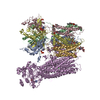
|
|---|---|
| 1 |
|
- Components
Components
-Protein , 2 types, 6 molecules ABCDEG
| #1: Protein | Mass: 48023.871 Da / Num. of mol.: 4 Source method: isolated from a genetically manipulated source Source: (gene. exp.)   Chlorocebus aethiops (grivet) / References: UniProt: Q63664 Chlorocebus aethiops (grivet) / References: UniProt: Q63664#2: Protein | Mass: 174488.562 Da / Num. of mol.: 2 Source method: isolated from a genetically manipulated source Source: (gene. exp.)   Chlorocebus aethiops (grivet) / References: UniProt: Q63563 Chlorocebus aethiops (grivet) / References: UniProt: Q63563 |
|---|
-Sugars , 1 types, 2 molecules
| #3: Polysaccharide |
|---|
-Non-polymers , 5 types, 21 molecules 

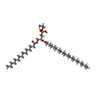
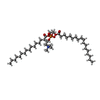
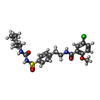




| #4: Chemical | | #5: Chemical | ChemComp-ATP / #6: Chemical | ChemComp-PTY / #7: Chemical | #8: Chemical | ChemComp-GBM / | |
|---|
-Details
| Has ligand of interest | Y |
|---|---|
| Has protein modification | Y |
-Experimental details
-Experiment
| Experiment | Method: ELECTRON MICROSCOPY |
|---|---|
| EM experiment | Aggregation state: PARTICLE / 3D reconstruction method: single particle reconstruction |
- Sample preparation
Sample preparation
| Component | Name: Vascular KATP channel: Kir6.1 SUR2B quatrefoil-like conformation 2 Type: COMPLEX / Entity ID: #1-#2 / Source: RECOMBINANT |
|---|---|
| Molecular weight | Value: 0.889 MDa / Experimental value: YES |
| Source (natural) | Organism:  |
| Source (recombinant) | Organism:  Chlorocebus aethiops (grivet) Chlorocebus aethiops (grivet) |
| Buffer solution | pH: 7.5 |
| Specimen | Embedding applied: NO / Shadowing applied: NO / Staining applied: NO / Vitrification applied: YES |
| Specimen support | Grid type: Quantifoil R2/1 |
| Vitrification | Cryogen name: ETHANE |
- Electron microscopy imaging
Electron microscopy imaging
| Experimental equipment |  Model: Titan Krios / Image courtesy: FEI Company |
|---|---|
| Microscopy | Model: FEI TITAN KRIOS |
| Electron gun | Electron source:  FIELD EMISSION GUN / Accelerating voltage: 300 kV / Illumination mode: SPOT SCAN FIELD EMISSION GUN / Accelerating voltage: 300 kV / Illumination mode: SPOT SCAN |
| Electron lens | Mode: BRIGHT FIELD |
| Image recording | Electron dose: 40 e/Å2 / Film or detector model: GATAN K3 (6k x 4k) |
- Processing
Processing
| EM software |
| ||||||||||||||||||||
|---|---|---|---|---|---|---|---|---|---|---|---|---|---|---|---|---|---|---|---|---|---|
| CTF correction | Type: NONE | ||||||||||||||||||||
| 3D reconstruction | Resolution: 4 Å / Resolution method: FSC 0.143 CUT-OFF / Num. of particles: 71880 / Symmetry type: POINT | ||||||||||||||||||||
| Atomic model building | PDB-ID: 6BAA Accession code: 6BAA / Source name: PDB / Type: experimental model |
 Movie
Movie Controller
Controller





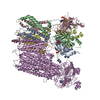


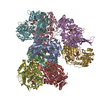


 PDBj
PDBj










